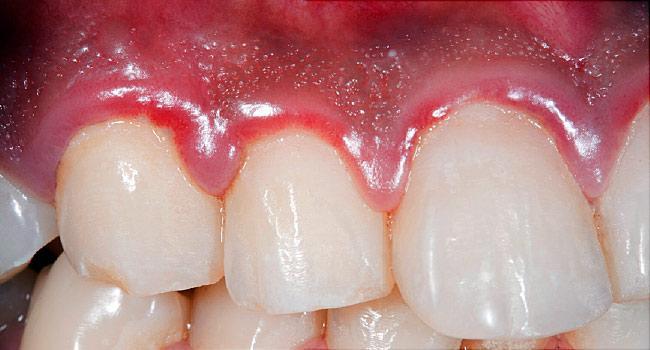


Gum disease is an inflammation of the gum line that can progress to affect the bone that surrounds and supports your teeth.
Gum disease is an inflammation of the gum line that can progress to affect the bone that surrounds and supports your teeth. Gum Disease also known as Periodontal Disease begins with bacterial growth in the mouth, the localized inflammation of the gingiva is initiated by bacteria in the dental plaque, which is a microbial biofilm that forms on the teeth and gingiva. Nearly 70% of the people are affected by this disease at some point in their life. Though such a prevalent disease most people are unaware of the issue and the problems it can cause.
The primary cause of Gum Disease is poor oral hygiene. If you are not brushing or flossing properly, then the chances of bacteria build-up are high. However, there are other reasons as well such as:
DO's
The stages of Gum Diseases are as follows:
GINGIVITIS
This is the first stage of gum disease, caused due to the plaque build-up on gums. If the
plaque is not gone after brushing and flossing, then it can cause irritation. In this stage,
you will notice your gums bleeding while brushing and flossing. Because bone is not affected
in this stage, the chances of recovery are quite high.
PERIODONTITIS
Gingivitis if not treated on time, can lead to Periodontitis. This stage starts affecting
your bone. Spaces are formed between bone and gum line as a result, bacteria will get a
space food lodgement. If you visit your dentist on time then Periodontitis can be prevented.
Periodontitis is an advanced gum disease.
ADVANCED PERIODONTITIS
This is the final stage of your gum disease where your bone is destroyed making your teeth
loosen further. This can only be saved with surgery. And if the case is very advanced then
even surgery cannot save your tooth, as a result, your dentist has to extract your
tooth.
The treatment option depends on the stage of Gum Disease. It also depends on your medical
history and your overall health.
The treatment options range from non-surgical therapies to surgical treatments.
The Non-Surgical Options Include:
Deep Cleaning
This is done in the very initial stage of developing a Gum Disease. Your dentist will remove
the plaque or tartar (which hardens the tooth surface) from below and above the gum line. It
is a preventive measure which helps you to save from getting gum disease.
Scaling & Root Planning
This is also a deep cleaning process. The only difference is that your dentist will give
local anaesthesia to start the process. Plaque and tartar are removed from above and below
the gum line and after that, the rough spots are made smooth. The process of smoothing helps
to remove the bacteria. This is done only if your dentist finds that you have calculus
deposits under the gum.
Surgical Treatment Includes:
Flap Surgery
In this, incision is made on the gums to remove the tartar. Sometimes the irregular surface
of the bone is smoothened so that there are no areas for bacteria which cause this disease
can hide. This method is used to remove the gap between gums and tooth.
Bone Graft
This method is used to regenerate the bone. The dentist use fragments of synthetic bone
donated bone or your own bone which is used to replace the bone destroyed due to gum
disease
Soft Tissue Graft
This method is used if the gums are receded. Gums are taken from the roof of the mouth and
is stitched to the area of gum recession.
Guided Tissue Regeneration
Done along flap surgery when bone which supports your teeth are destroyed. Your dentist will
insert a small piece of mesh-like fabric between your bone and gum tissue.
The progression and the location of gum disease are the main factors responsible for the difference in price for its treatment. Delaying gum problems not only affects oral health as a whole, it directly impacts overall health for instance, its directly related to increased risk of heart disease. At 2HF Dental, in India, gum diseases are cured at competitive prices.
Q.1. Can Gum Disease Be Treated On Its Own?
No, gum diseases cannot be treated on its own. Gum diseases are caused by the development of
tartar on the teeth leading to gum infection. This requires dental cleaning and good oral
care routine. Get professional cleaning at your nearest Clove Dental clinic.
Q.2. How Long Does It Take For Gum Disease To Be Cured?
Gum diseases are categorized into 4 stages, gingivitis, slight periodontal disease, moderate
periodontal disease, and advanced periodontal disease. Curing gum diseases and gum infection
depends on the stage at which treatment begins. The recovery time at stage one is 10-14
days.
Q.3. Is Gum Disease Treatable?
Yes, gum diseases are treatable. The recovery and treatment duration depends on the stage at
which a gum infection is identified and preventive measures are taken.
Q.4. What Is The First Sign Of Gum Disease
The first sign of gum disease is red, tender and swollen gums that cause discomfort and
pain. Gums can also bleed while brushing, which is commonly considered as a sign of
gingivitis-stage one of gum diseases.